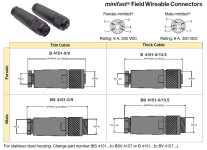The Plc Kid
Member
What is the best way to join devicenet thick cable?
I have a cabinet that we will be moving about 10-15 feet soon and this is a pretty long devicenet trunk run in a real tight conduit and i would prefer to just add to it before repuling the entire run.
After the move the cable may be long enogh to get into the cabinet 1-2 feet at most or we may have to set a junction box.
I was looking at a devicenet powertap to join the cables but not sure if that is the best way.Money is not a problem i just want the best and most fault tolerant method and wanted to get some advice before i purchase.
BTW this will be the end of the run on this devicenet network and i will be adding 20 feet of cable max. I have done the length calculations already and i am well in range.
I have a cabinet that we will be moving about 10-15 feet soon and this is a pretty long devicenet trunk run in a real tight conduit and i would prefer to just add to it before repuling the entire run.
After the move the cable may be long enogh to get into the cabinet 1-2 feet at most or we may have to set a junction box.
I was looking at a devicenet powertap to join the cables but not sure if that is the best way.Money is not a problem i just want the best and most fault tolerant method and wanted to get some advice before i purchase.
BTW this will be the end of the run on this devicenet network and i will be adding 20 feet of cable max. I have done the length calculations already and i am well in range.



